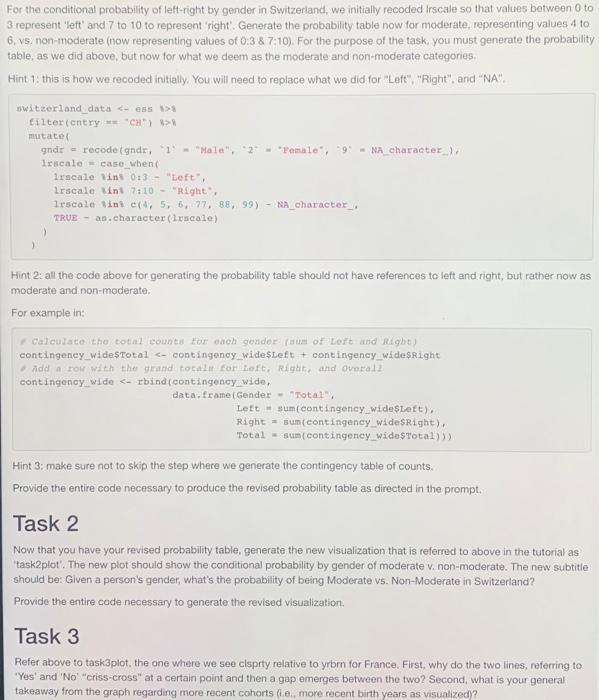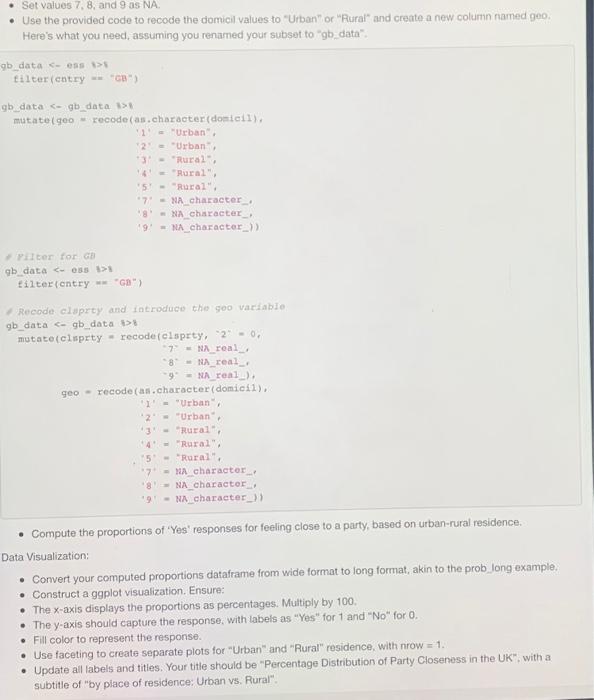Answered step by step
Verified Expert Solution
Question
1 Approved Answer
For the conditional probability of left-right by gender in Switzerland, we initially recoded Irscale so that values between 0 to 3 represent 'left' and



For the conditional probability of left-right by gender in Switzerland, we initially recoded Irscale so that values between 0 to 3 represent 'left' and 7 to 10 to represent 'right'. Generate the probability table now for moderate, representing values 4 to 6, vs. non-moderate (now representing values of 0:3 & 7:10). For the purpose of the task, you must generate the probability table, as we did above, but now for what we deem as the moderate and non-moderate categories. Hint 1: this is how we recoded initially. You will need to replace what we did for "Left", "Right", and "NA". switzerland_data 1 filter (cntry == "CH") > mutate( gndr = recode (gndr, "1 "Male", - "Female", "9" NA character_), 1rscale case_when ( 1rscale ins 0:3 "Left", irscale sint 7:10 "Right", Irscale sint c(4, 5, 6, 77, 88, 99) - NA character, TRUE as.character (1rscale) Hint 2: all the code above for generating the probability table should not have references to left and right, but rather now as moderate and non-moderate. For example in: Calculate the total counts for each gender (sum of Left and Right) contingency wideSTotal Task 4 You must make changes to the last visualization we produced, referred to as "task4plot". Specifically, you must do the following three adjustments: 1. Truncate to year born 1950 onwards. 2. Remove the facet wrap 3. Remove the y-axis limits from 0 to 1. GGplot will automatically truncate the y-axis. Generate and interpret. Provide the entire code necessary to generate the revised visualization, as well as your interpretation. Specifically, tell us, what do you notice in the comparison between Spain, Italy, France, and Norway. What stands out to you in terms of the overall trends across the countries, as well as the striking patterns for individual countries (i.e., highlight 2 countries and what you notice). Task 5 This task will involve different components covered in the tutorial that you must piece together, as well as a new categorical variable (place of residence), for which the coding is provided below. Main objective: Create a visual representation that illustrates the percentage of individuals in the UK who feel close to a political party vs. do not feel close to a party, by place of residence (categorized as urban or rural). For this task, you'll focus on the entries where cntry is "GB" (United Kingdom). Here's a rundown of what you need to do, all referring to code you encountered above in the tutorial: Data Cleaning and Transformation: Filter the dataset to focus only on the United Kingdom. Recode the clsprty values: specifically 2 now set to 0. Set values 7, 8, and 9 as NA. Use the provided code to recode the domicil values to "Urban" or "Rural" and create a new column named geo. Here's what you need, assuming you renamed your subset to "gb_data". gb_data filter (entry "GB") gb_data mutate (geo recode(as.character (domicil), '1' "Urban", Filter for GB 000121 2 "Urban". 3 "Rural", '4" "Rural", 155 "Rural", 7) -NA character_ '8" =NA character, 19" NA character_)) Set values 7, 8, and 9 as NA. Use the provided code to recode the domicil values to "Urban" or "Rural" and create a new column named geo. Here's what you need, assuming you renamed your subset to "gb_data". gb_data 1 filter (entry== "GB") gb_data mutate (geo recode (as.character (domicil), 1 = "Urban", *2= "Urban", 3- "Rural", "Rural", "Rural", 4 '5 "7" -NA character "8" 19 Pilter for CB gb_data 1 filter(entry "GB") ww NA character, NA character_)) Recode claprty and introduce the geo variable gb_data mutate (claprty recode(clsprty, 20, "7" - NA_real_ NA_real_. 8 -9 NA_real_), geo recode (as.character (domicil), 'I' "Urban", 2 "Urban" 3 "Rural") A "Rural", '5' - "Rural", "7" NA character. 8 NA character, -NA character_)) Compute the proportions of 'Yes' responses for feeling close to a party, based on urban-rural residence. Data Visualization: Convert your computed proportions dataframe from wide format to long format, akin to the prob_long example. Construct a ggplot visualization. Ensure: The x-axis displays the proportions as percentages. Multiply by 100. The y-axis should capture the response, with labels as "Yes" for 1 and "No" for 0. Fill color to represent the response. Use faceting to create separate plots for "Urban" and "Rural" residence, with nrow = 1. Update all labels and titles. Your title should be "Percentage Distribution of Party Closeness in the UK", with a subtitle of "by place of residence: Urban vs. Rural".
Step by Step Solution
★★★★★
3.41 Rating (151 Votes )
There are 3 Steps involved in it
Step: 1
The skin friction coefficient Cf for a laminar boundary ...
Get Instant Access to Expert-Tailored Solutions
See step-by-step solutions with expert insights and AI powered tools for academic success
Step: 2

Step: 3

Ace Your Homework with AI
Get the answers you need in no time with our AI-driven, step-by-step assistance
Get Started


